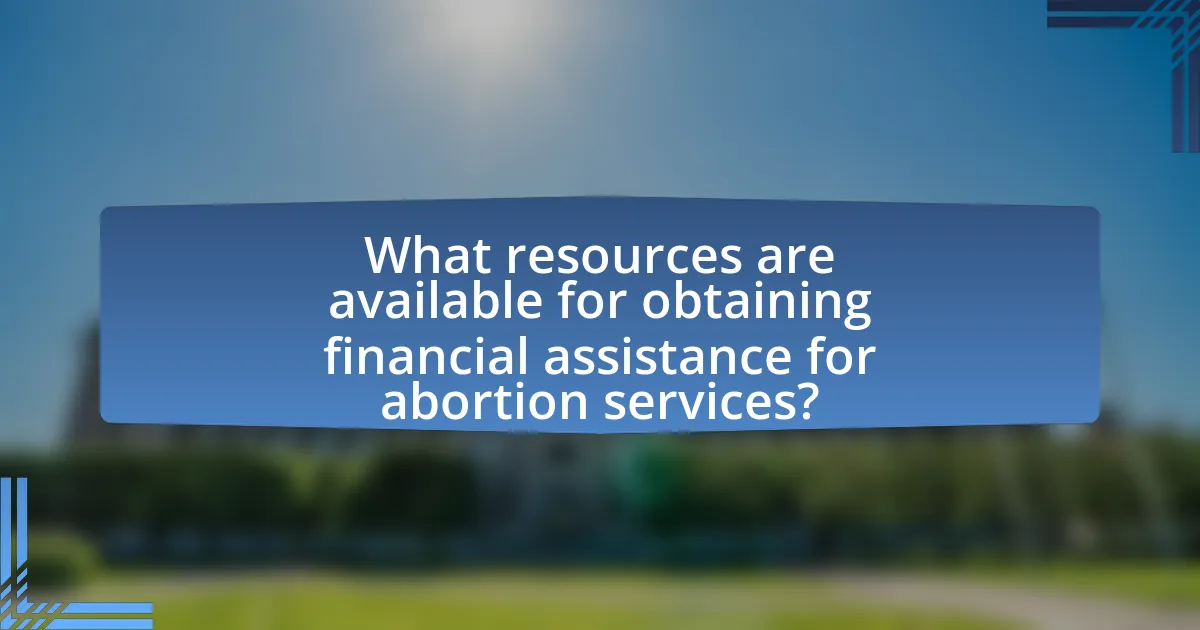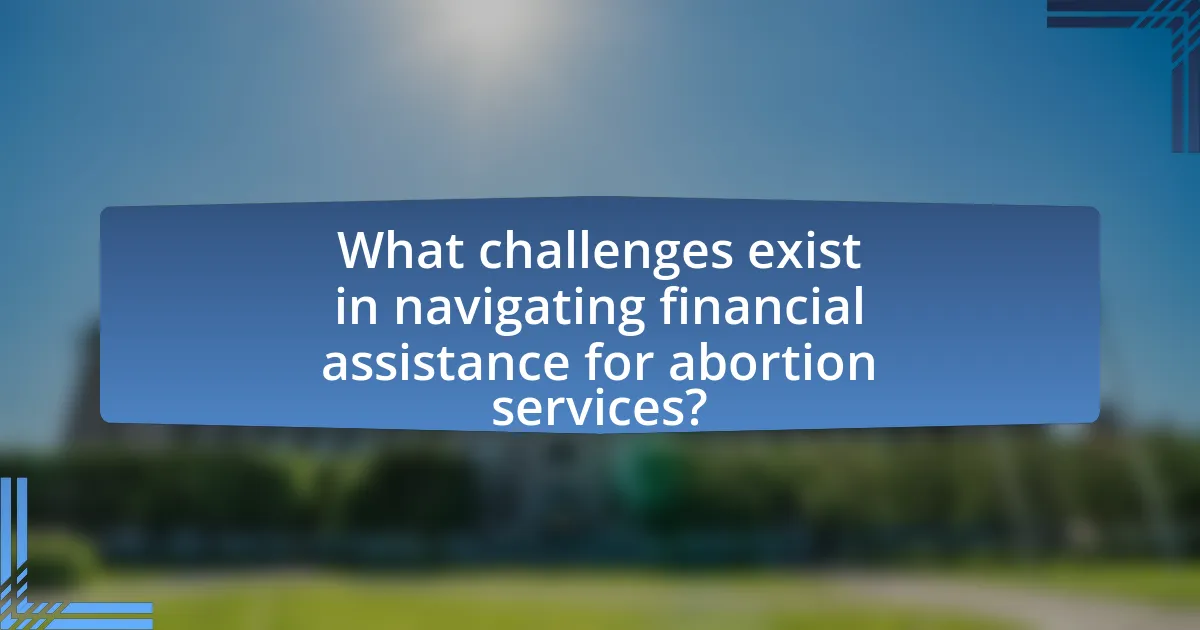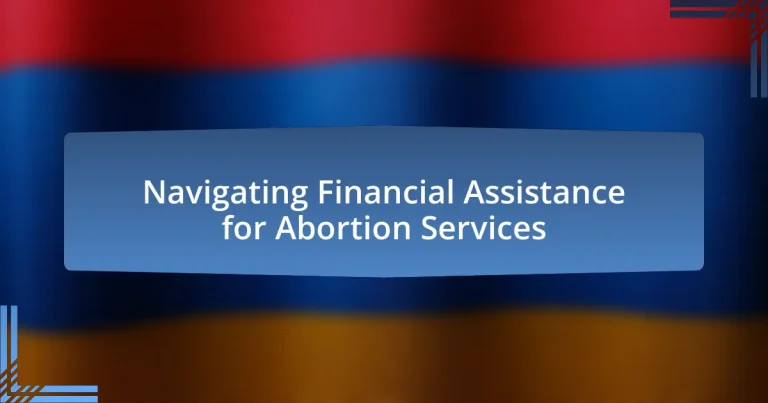Financial assistance for abortion services is crucial for individuals who may struggle to afford the costs associated with abortion procedures. This article outlines the various sources of financial support, including non-profit organizations, government programs, and healthcare providers, which aim to alleviate financial barriers and promote equitable access to reproductive healthcare. It discusses the types of assistance available, eligibility criteria, and the impact of financial support on individuals seeking abortions. Additionally, the article highlights the challenges faced in navigating these resources, including stigma and misinformation, while providing strategies for effectively accessing financial assistance.

What is Financial Assistance for Abortion Services?
Financial assistance for abortion services refers to financial support provided to individuals seeking abortion procedures who may not have the means to afford them. This assistance can come from various sources, including non-profit organizations, government programs, and healthcare providers, aimed at reducing the financial burden associated with abortion care. For instance, organizations like the National Network of Abortion Funds help connect individuals with local funds that can cover costs related to the procedure, travel, and other associated expenses. According to a report by the Guttmacher Institute, financial barriers significantly impact access to abortion services, highlighting the importance of such assistance in ensuring equitable healthcare access.
How does financial assistance for abortion services work?
Financial assistance for abortion services typically works through various funding sources, including non-profit organizations, state programs, and private donations. These entities provide financial support to individuals seeking abortions, often covering costs such as the procedure itself, travel expenses, and related healthcare services. For example, organizations like the National Network of Abortion Funds help connect individuals with local funds that can assist with costs, while some states have programs that allocate public funds for low-income individuals. According to the Guttmacher Institute, approximately 25% of women who seek abortions report financial barriers, highlighting the importance of these assistance programs in ensuring access to necessary healthcare services.
What are the different types of financial assistance available?
Different types of financial assistance available for abortion services include grants, loans, and sliding scale fees. Grants are often provided by nonprofit organizations and can cover the full cost of the procedure, while loans may offer funds that need to be repaid over time. Sliding scale fees adjust the cost based on the patient’s income, making services more affordable. Organizations like the National Network of Abortion Funds report that they help thousands of individuals access these financial resources, demonstrating the availability and impact of such assistance.
How do eligibility criteria affect access to financial assistance?
Eligibility criteria significantly influence access to financial assistance by determining who qualifies for support based on specific requirements such as income level, residency, and medical necessity. For instance, many financial assistance programs for abortion services require applicants to demonstrate a low income, which can exclude individuals who do not meet these financial thresholds, thereby limiting their access to necessary care. Research indicates that restrictive eligibility criteria can lead to disparities in access, as highlighted in a study by the Guttmacher Institute, which found that 40% of women seeking abortions reported financial barriers, often exacerbated by stringent eligibility requirements.
Why is financial assistance important for abortion services?
Financial assistance is crucial for abortion services because it ensures access to safe and legal procedures for individuals who may face financial barriers. Many people seeking abortions come from low-income backgrounds, where the cost of the procedure can be prohibitive; for instance, a study by the Guttmacher Institute found that nearly 75% of women who seek abortions are low-income. Without financial support, these individuals may be forced to carry unwanted pregnancies to term, which can have significant physical, emotional, and economic consequences. Thus, financial assistance plays a vital role in promoting reproductive autonomy and health equity.
What impact does financial assistance have on individuals seeking abortion services?
Financial assistance significantly increases access to abortion services for individuals facing economic barriers. Studies indicate that when financial support is available, individuals are more likely to obtain the procedure, as costs can be a primary deterrent. For instance, research published by the Guttmacher Institute shows that nearly 40% of women seeking abortions cite financial constraints as a reason for not being able to access the service. Additionally, organizations providing financial assistance report that their support leads to higher rates of successful abortion access, thereby reducing the likelihood of negative health outcomes associated with delayed or denied care.
How does financial assistance contribute to reproductive health equity?
Financial assistance contributes to reproductive health equity by reducing financial barriers that disproportionately affect low-income individuals seeking reproductive health services. Access to funding enables these individuals to obtain necessary services, such as abortion, without the burden of high costs that can lead to delays or denials of care. For instance, studies show that women who face financial obstacles are more likely to experience negative health outcomes, highlighting the importance of financial support in ensuring equitable access to reproductive health services.

What resources are available for obtaining financial assistance for abortion services?
Financial assistance for abortion services can be obtained through various organizations and funds. Notable resources include the National Abortion Federation, which provides a toll-free hotline for financial assistance, and the Abortion Care Network, which connects individuals with local clinics that may offer sliding scale fees or financial aid. Additionally, state-specific funds, such as the California Abortion Fund, offer support for residents seeking abortion services. These organizations often rely on donations and grants to assist individuals in need, ensuring access to safe and legal abortion care.
How can individuals find financial assistance programs?
Individuals can find financial assistance programs by researching online resources, contacting local healthcare providers, and reaching out to nonprofit organizations that specialize in reproductive health. Websites such as the National Abortion Federation and Planned Parenthood provide directories of financial assistance options. Additionally, local clinics often have information on state-specific programs and can guide individuals through the application process. According to the Guttmacher Institute, many states offer funding for low-income individuals seeking abortion services, which can be accessed through these channels.
What online resources provide information on financial assistance for abortion services?
Online resources that provide information on financial assistance for abortion services include the National Abortion Federation (NAF), which offers a hotline and a directory of funding sources, and Planned Parenthood, which provides information on financial assistance options available at their clinics. Additionally, the Abortion Care Network lists various funds and organizations that assist with costs related to abortion services. These resources are validated by their established presence in reproductive health advocacy and their commitment to supporting individuals seeking abortion care.
How can healthcare providers assist in connecting patients to financial resources?
Healthcare providers can assist in connecting patients to financial resources by offering information on available funding options and facilitating access to financial assistance programs. They can provide patients with brochures or direct them to websites that list organizations offering grants, loans, or sliding scale fees specifically for abortion services. Additionally, healthcare providers can collaborate with social workers or financial counselors who specialize in reproductive health to guide patients through the application processes for these resources. Studies indicate that when healthcare providers actively engage in this support, patients are more likely to utilize available financial assistance, thereby reducing barriers to care.
What organizations offer financial assistance for abortion services?
Organizations that offer financial assistance for abortion services include the National Network of Abortion Funds, Planned Parenthood, and the Abortion Care Network. The National Network of Abortion Funds provides a comprehensive list of local funds that help individuals cover the costs of abortion services, while Planned Parenthood offers financial assistance and sliding scale fees based on income. The Abortion Care Network connects patients with resources and funds to help alleviate the financial burden of abortion procedures. These organizations are recognized for their commitment to ensuring access to abortion services regardless of financial circumstances.
What role do non-profit organizations play in providing financial support?
Non-profit organizations play a crucial role in providing financial support by offering grants, funding, and resources to individuals seeking abortion services. These organizations often fill gaps left by government funding and private insurance, ensuring that low-income individuals have access to necessary healthcare. For instance, the National Network of Abortion Funds has distributed millions of dollars to help cover the costs of abortion procedures, demonstrating the significant financial impact non-profits have in this area. Additionally, non-profits often collaborate with healthcare providers to create financial assistance programs, further enhancing access to abortion services for those in need.
How do state and federal programs contribute to financial assistance for abortion services?
State and federal programs contribute to financial assistance for abortion services primarily through Medicaid funding and specific state-level initiatives. Medicaid, a federal-state program, allows states to use federal funds to cover abortion services for low-income individuals, although this is subject to state-specific restrictions and eligibility criteria. For instance, as of 2023, 16 states have expanded Medicaid to include abortion services, providing financial support to those who qualify. Additionally, some states have established their own funds or programs to assist with abortion costs, often funded through private donations or state budgets, further enhancing access to these services. These programs collectively aim to reduce the financial burden on individuals seeking abortions, thereby improving access to reproductive healthcare.

What challenges exist in navigating financial assistance for abortion services?
Navigating financial assistance for abortion services presents several challenges, including limited availability of funds, varying eligibility criteria, and misinformation about resources. Many organizations that provide financial assistance have restricted budgets, which can lead to long wait times or insufficient support for those in need. Additionally, eligibility requirements often differ among funding sources, making it difficult for individuals to determine which programs they qualify for. Misinformation can further complicate the process, as individuals may not be aware of all available options or may receive incorrect guidance from unverified sources. These factors collectively hinder access to necessary financial support for abortion services.
What barriers do individuals face when seeking financial assistance?
Individuals face several barriers when seeking financial assistance for abortion services, including lack of awareness about available resources, restrictive eligibility criteria, and stigma associated with abortion. Many individuals are unaware of the financial assistance programs that exist, which can lead to missed opportunities for support. Additionally, eligibility criteria for these programs can be stringent, often requiring specific income levels or residency status, which may exclude those in need. Stigma surrounding abortion can further complicate the process, as individuals may feel uncomfortable seeking help or discussing their situation with others. These barriers collectively hinder access to necessary financial support for abortion services.
How do stigma and misinformation affect access to financial assistance?
Stigma and misinformation significantly hinder access to financial assistance for abortion services by creating barriers that discourage individuals from seeking help. Stigma surrounding abortion often leads to feelings of shame and isolation, causing individuals to avoid reaching out for financial support due to fear of judgment or discrimination. Misinformation about the availability and eligibility for financial assistance can further exacerbate this issue, as individuals may believe they do not qualify for help or that assistance is not available to them. Research indicates that 60% of individuals seeking abortion services report concerns about stigma, which directly impacts their willingness to seek financial aid (Guttmacher Institute, 2021). This combination of stigma and misinformation ultimately results in reduced access to necessary financial resources, making it more challenging for individuals to obtain abortion services.
What legal and policy challenges impact financial assistance availability?
Legal and policy challenges significantly impact the availability of financial assistance for abortion services. These challenges include restrictive state laws that limit funding sources, such as the Hyde Amendment, which prohibits federal funds from being used for abortions except in specific circumstances. Additionally, varying state regulations create a patchwork of access, where some states impose waiting periods, mandatory counseling, and parental consent laws, further complicating financial assistance efforts. Research indicates that these legal barriers disproportionately affect low-income individuals, as they often lack the resources to navigate complex funding options and may face additional costs related to travel and accommodation.
How can individuals overcome challenges in accessing financial assistance?
Individuals can overcome challenges in accessing financial assistance for abortion services by utilizing available resources and support networks. Many organizations, such as the National Abortion Federation and Planned Parenthood, provide financial assistance programs specifically designed to help individuals cover the costs of abortion services. Additionally, individuals can seek out local clinics that may offer sliding scale fees based on income, which can significantly reduce out-of-pocket expenses. Research indicates that nearly 50% of women seeking abortions report financial constraints as a barrier, highlighting the importance of these resources in facilitating access to care. By actively engaging with these organizations and exploring community resources, individuals can effectively navigate the financial challenges associated with obtaining abortion services.
What strategies can individuals use to effectively navigate financial assistance programs?
Individuals can effectively navigate financial assistance programs by researching available options, understanding eligibility criteria, and preparing necessary documentation. Researching involves identifying local, state, and national programs that provide financial aid for abortion services, such as the National Abortion Federation or Planned Parenthood. Understanding eligibility criteria is crucial, as many programs have specific requirements based on income, residency, or medical necessity. Preparing necessary documentation, such as proof of income and identification, streamlines the application process and increases the likelihood of approval. According to a study by the Guttmacher Institute, 75% of women seeking abortions cite financial constraints, highlighting the importance of utilizing these strategies to access needed services.
How can community support networks enhance access to financial assistance?
Community support networks enhance access to financial assistance by providing localized resources, information, and emotional support to individuals seeking help. These networks often include organizations that specialize in reproductive health, which can connect individuals with financial aid programs specifically designed for abortion services. For instance, studies show that organizations like the National Network of Abortion Funds have successfully raised millions of dollars to assist individuals in need, demonstrating the effectiveness of community-driven fundraising efforts. Additionally, community support networks facilitate peer-to-peer sharing of information about available financial resources, ensuring that individuals are aware of their options and can navigate the often complex landscape of financial assistance for abortion services.
What are the best practices for utilizing financial assistance for abortion services?
The best practices for utilizing financial assistance for abortion services include researching available funding sources, understanding eligibility criteria, and maintaining clear communication with service providers. Individuals should start by identifying organizations that offer financial aid, such as Planned Parenthood or the National Abortion Federation, which provide resources and support for those in need. It is crucial to review the eligibility requirements for each funding source to ensure that one qualifies for assistance. Additionally, maintaining open communication with healthcare providers can help clarify costs and available financial options, ensuring that individuals can make informed decisions about their care. These practices are supported by data indicating that access to financial assistance significantly increases the likelihood of obtaining necessary abortion services, as highlighted in studies by the Guttmacher Institute.
How can individuals ensure they are maximizing available financial resources?
Individuals can maximize available financial resources by thoroughly researching and utilizing all available financial assistance programs specific to abortion services. Many organizations, such as the National Abortion Federation and Planned Parenthood, provide financial aid, sliding scale fees, and information on state-specific funding options. Additionally, individuals should assess their eligibility for government programs like Medicaid, which may cover abortion costs in certain states. By actively seeking out these resources and understanding the criteria for assistance, individuals can effectively reduce their out-of-pocket expenses related to abortion services.
What tips can help individuals prepare for the financial assistance application process?
To prepare for the financial assistance application process, individuals should gather all necessary documentation, including proof of income, identification, and any relevant medical records. This preparation is crucial because many financial assistance programs require specific information to assess eligibility. For instance, having recent pay stubs or tax returns can expedite the review process, as these documents provide clear evidence of financial need. Additionally, individuals should research available programs and understand their eligibility criteria, which can vary significantly. This knowledge allows applicants to tailor their submissions effectively, increasing the likelihood of approval.


